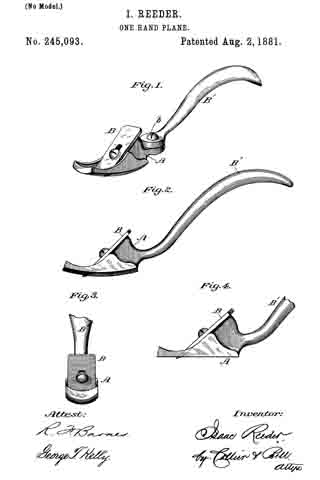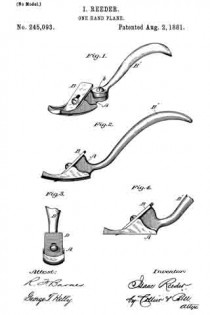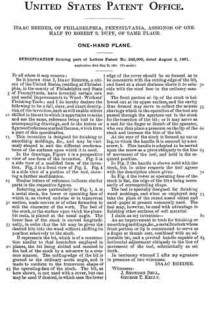No. 245,093 – One-Hand Plane (Isaac Reeder) (1881)

UNITED STATES PATENT OFFICE.
_________________
ISAAC REEDER, OF PHILADELPHIA, PENNSYLVANIA, ASSIGNOR OF ONE-HALF TO ROBERT S. DUFF, OF SAME PLACE.
ONE-HAND PLANE.
_________________
SPECIFICATION forming part of Letters Patent No. 245,093, dated August 2, 1881.
Application filed May 26, 1881. (No model.)
_________________
To all whom it may concern:
Be it known that I, ISAAC REEDER, a citizen of the United States,residing at Philadelphia, in the county of Philadelphia and State of Pennsylvania, have invented certain new and useful Improvements in Wood-Workers’ Finishing-Tools; and I do hereby declare the following to be a full, clear, and exact description of the invention, such as will enable others skilled in the art to which it appertains to make and use the same, reference being had to the accompanying drawings, and to the letters or figures of reference marked thereon, which form a part of this specification.
This invention is designed for finishing or smoothing moldings, &c., and may be variously shaped to suit the different conformations of the surfaces upon which it is used.
In the drawings, Figure 1 is a perspective view of one form of the invention. Fig. 2 is a side view of a niodided form of the invention. Fig. 3 is a front view of Fig. 2. Fig. 4 is a side view of a portion of the tool, showing a further modification.
Similar letters of reference indicate similar parts in the respective figures.
Referring more particularly to Fig. 1, A is a metal stock, the lower or operating face of which is, as viewed endwise or in transverse section, made convex or of other formation to suit the character of the work. The bed of the stock, or the surface upon which the plane-bit rests, is placed at the usual angle. The lower face of the stock is curved longitudinally, in order that the bit may be given the desired bite into the wood without shifting its position relatively to the stock.
B represents the bit, which is of a construction similar to that heretofore employed in planes, the bit being slotted and secured to the bed of the stock by a set-screw in a common manner. The cutting-edge of the bit is ground to the ordinary acute angle, and is made to conform to the transverse shape of the operating-face of the stock. The bit, as here shown, is not used. with a cover, but one may be used if desired, in which case the lower edge of the cover should be so formed as to be concentric with the cutting-edge of the bit, and fixed at a short distance above it to coincide with the steel face in the ordinary manner.
The front portion or lip of the stock is hollowed out at its upper surface, and the cavity thus formed may serve to collect the minute shavings which in the operation of the tool are passed through the aperture cut in the stock for the insertion of the bit; or it may serve as a rest for the finger or thumb of the operator, who can thus place a pressure on the lip of the stock and increase the bite of the bit.
At the rear of the stock is formed an ear or lug, to which the handle B is secured by a set-screw, b. This handle is adapted to be moved upon the screw as a pivot obliquely to the line of movement of the tool, and held in the required position.
In Fig. 2 the handle is shown solid with the stock, but in other respects the tool agrees with the description above given.
In Fig. 4 the lower or operating face of the stock is flat, the edge of the bit a, being necessarily of corresponding shape.
The tool is specially designed for finishing wood moldings, and when so employed may take the place of the round-nosed chisel and sand-paper at present commonly used. The tool may, however, be used with advantage in finishing other surfaces of soft material.
I claim as my invention —
As an improvement in tools for finishing or smoothing moldings, &c., a metallic stock whose front portion or lip is constructed to serve as a finger or thumb rest, combined with an adjustable bit, and a pivoted handle capable of horizontal adjustment obliquely to the line of movement of the tool, substantially as set forth.
In testimony whereof I affix my signature in presence of two witnesses.
ISAAC REEDER.
Witnesses:
J. SNOWDEN BELL,
GEORGE T. KELLY.


